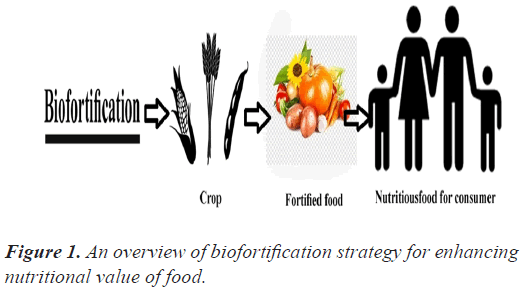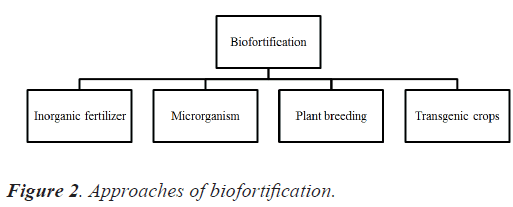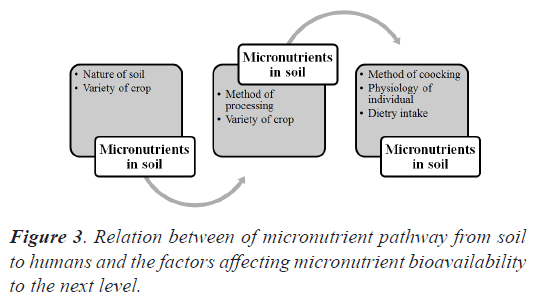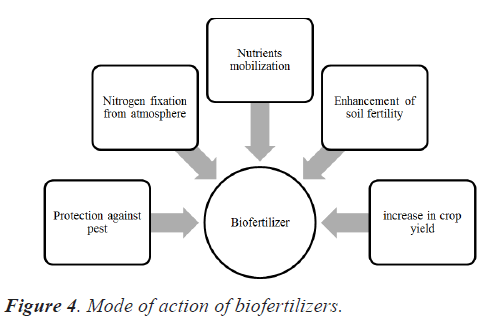ISSN: 0970-938X (Print) | 0976-1683 (Electronic)
Biomedical Research
An International Journal of Medical Sciences
Review Article - Biomedical Research (2022) Volume 33, Issue 5
Biofortification: A weapon against hidden hunger.
Shubham E Perane*, Vipul P Patel
Department of Pharmaceutics, Sanjivani College of Pharmaceutical Education and Research, Kopargaon-423603, Maharashtra, India
- Corresponding Author:
- Shubham E. Perane
Department of Pharmaceutics
Sanjivani College of Pharmaceutical Education and Research
Kopargaon
Maharashtra
India
Accepted date: June 27, 2022
When the diet of a person is unable to fulfill the daily requirements of micronutrients is known as malnutrition. Micronutrients including vitamins and minerals are essential for various physiological functions in the body. When the food becomes deficient in micronutrients hidden hunger is developed in the population especially those belonging to the economically weaker class. According to the statement of UNICEF, 80 percent of adolescents from India are affected by hidden hunger. Malnutrition has become worst because the agriculture sector is focusing only on the quantity of yield and not on its nutritional value. Malnutrition not only affects personal health but also on productivity of the nation. Biofortification is a promising tool to overcome due to its advantages. Biofortification is nothing but increasing the nutrition of crops. It includes different approaches such as crop breeding, use of inorganic fertilizers, transgenic crops. Biofortification is considered sustainable and cost-friendly because targeted crops are part of the diet of the most population.
Keywords
Micronutrients, Minerals, Vitamins, Biofortification.
Introduction
Fortification
The first use of the fortification technique was stated to overcome nutritional deficiencies within the people during the first and second World Wars. European countries as well as the USA made fortification a compulsory practice. According to WHO, fortification is nothing but the practice of deliberately increasing content of an essential micronutrient i.e. vitamins and minerals in food to enhance the nutrition quality of the food supply and providing public health benefits with the minimum risk associated with health [1]. A most common example of fortification is milk which is fortified with the addition of Vitamin D3 and calcium which is needed by the body for stronger bones, teeth, muscle function, and nerve signaling [2]. In general addition of one or more vitamins and essential minerals to commonly consumed food is the target of fortification. The ultimate goal of fortification is to tackle hidden hunger. Lack of vitamins and minerals is coined as hidden hunger [3]. According to the report published by UNICEF 80% adolescents are under darkness of hidden hunger [4]. When the quality of the food which people eat is unable to meet their nutrient requirements, hence the food is lacking in micronutrients like vitamin and minerals which is required by the people for their growth and development at that time hidden hunger occurs (Figure 1).
Biofortification
Biofortification is the kind of process which targets to enhance the micronutrient qualities of the crop with the help of traditional as well as a modern technique like genetic engineering, breeding technology. Biofortification not only focuses on the nutritional levels but increases bioavailability. Breeds which often cultivated and consumed are preferred for biofortification strategies. Plant breeding and genetic Engineering are two options which lead to influence the availability of micronutrients [5,6]. Mostly world wild agriculture system was based only on the profit system. Even the Green revolution was only focused on the increase in yield. The agriculture revolution produced a positive impact on reducing hunger but later on, there was a rapid rise in a hidden hunger (Figure 2).
Minerals and Vitamins
A human requires macronutrients and micronutrients. For the release of energy, humans need macronutrients such as carbohydrates, fat, and proteins. In the case of macronutrients, one can be substituted by another one. But this is not possible in the case of micronutrients. They are essential to carry out metabolic pathways and maintaining tissue functioning [7,8]. Vitamins and minerals are two of the essential nutrients for the human body to grow and stay healthy. There are thirteen types of vitamins: vitamins A, C, D, E, K, and B-complex (thiamine, riboflavin, niacin, pantothenic acid, biotin, B6, B12, and folate). Vitamins A, D, E, K are fat-soluble and the rest of the vitamins are water-soluble [9]. The body needs a lot of minerals like calcium, magnesium, and potassium. Some minerals, such as iodine and fluoride, are only needed in small amounts. Like vitamins, minerals can also be obtained from a diverse diet [10].
Following are some vitamins and minerals are discussed which are most essential for vital function of body that are most common causes of malnutrition.
Vitamin D
According to the estimation near about 1 billion people are suffering from Vitamin D deficiency. Vitamin D is also known by the popular name "the sun vitamin" due to its correlation with Vitamin D3 which is produced by the influence of ultraviolet radiation from the sun. Approximately 90% of vitamin D is gained by sunlight [11].
Daily requirement: 20 mg
Function:
a) Bone health in children
b) To prevent osteoporosis
c) To balance the calcium and phosphorous ratio in the body [12].
Vitamin E
Vitamin E is a lipid-soluble vitamin which is also known as Tocopherol. It is the main component of the antioxidant system of the human body. The antioxidant property of Vitamin E leads to more importance. Oxidant property is related to cancer, aging, cataract, and arthritis [13].
Daily requirement: 15 mg
Function:
a) Prevents oxidative stress.
b) Stimulation of the immunity system [14].
Vitamin A
Vitamin A was the first-ever vitamin that was identified. It is estimated that the 10.02 billion populations in the world is affected by the deficiency of Vitamin A. Most cases are observed in developing countries. Insufficient dietary intake and poor absorption are the prior reasons for deficiency. The most abundant form of vitamin A in the human diet is retinyl ester and retinol. Vitamin A is essential for growth, reproduction, and for fighting against diseases [15,16].
Daily requirement: 10-15 mg
Function:
a) Regulation of immunity system [17]
b) Essential for Vision [18]
c) Functioning of reproductive health [19]
d) Regulation of cell growth and differentiation [20].
Zinc
Though all micronutrients are equally important but among them, zinc is one of the important minerals, because deficiency of zinc results in the appearance of the disease. Zinc performance three biological functions in which it acts as a catalyst, structural as well as a regulatory ion. Zinc deficiency is more prevalent in areas of more cereal and less animal food consumption [21].
Daily requirement: Upto 15 mg [22]
Function:
a) Regulation of immune system [23]
b) Proper growth and development [24]
c) Functioning of reproductive health [25].
Iron
Anemia is affecting billions of people worldwide due to deficiency of Iron. As Iron plays a vital role in metabolic activity such as DNA synthesis, transportation of oxygen, transportation of electrons hence becomes an essential element of all living organisms [26,27].
Function:
a) Transport of oxygen [28]
b) Transport of electron [29]
c) Regulation of temperature [30]
d) Regulation of muscular activity [31]
e) Development of brain [32]
Calcium
Calcium is mostly related with formation and metabolism of bone tissue which is involved in much physiological and pathological process. Major source of calcium in body is calcium hydroxyapatite which is available in bone. Calcium is responsible for providing strength for tissue. Calcium is important micronutrient which regulates heart action, muscle contraction as well as healthy bones [33].
Daily requirement: 1000-1300 mg [33]
Function:
a) Maintaining bone health [34]
b) Regulation of muscle contraction [35]
c) Conduction of nerve impulse [36]
Though biofortified crops have many numbers of advantages still there is lack of consciousness in people. This is the reason why lagging in acceptance of biofortified verities. Also, less yielding capacity biofortified species decreased interest by the farmers. Besides, biofortified varieties and conventional varieties have the difference in the appearance also produce the impact on acceptance by consumers at village level [6].
Biofortification should pusses following characteristics
a) Breeding should increase the number of micronutrients in given staple food.
b) Breeding must have enough and a notable effect on nutritional value.
c) Should affordable to grow fortified species by producers.
d) Enough awareness should be done in consumers to buy/ eat fortified products [37].
Approaches for biofortification of crops
Biofortification is possible through following ways.
Inorganic fertilizers
The role of fertilizer is to replace the nutrients which are used by the crops from the soil. If not used it would affect the yield of the crop as well as the amount of micronutrients. To conquer deficiencies of micronutrient use of the Agronomic biofortification is the accelerated and cheaper way. The presence of enough amounts of Iron, Zinc, and Copper ensures the availability of these micronutrients in the crop. So there is a direct relation between the amounts of available micronutrients in the soil to the quantity of micronutrients in the crop. So the developing countries are working on that fact by making the soil more fertile for breeding for increased micronutrient density [38,39]. The factor which affects the bioavailability of micronutrients from soil to crop includes pH, soil aeration, presence of organic matter and their interaction with remaining elements, etc. Example: FeSO4, eEDTA, FeDTPA, FeIDHA (Iminodisuccinic acid), FeEDDHA, and Fecitrate are one of the inorganic and chelated forms of Iron fertilizers for tackling Iron deficiency in crop [40]. Also, it is observed that Nitrogen fertilizer increases the Iron concentration in crops [41]. Supply of Sulphur higher the content of Sulphur containing amino acid in grains. Vitamin C is increased by the use of Fertilizer containing Potassium (Figure 3).
Transgenic crops
Transgenic crops are the modern weapon to battle against the insufficiency of micronutrients [42]. When a Fragment of the gene which is called the DNA of crop is modified by the means of genetic engineering technique is called is Transgenic crops. DNA which is to be transferred is taken from the elite species for respective property [43]. The purpose of addition of new trait to the crop which is not present naturally in the species is achieved by transgenic crop. A transgenic crop has gene or genes which not present already is artificially inserted. Transgene which is inserted gene sequence is derived from another crop irrespective of the species. The ultimate goal of a transgenic crop is advantageous and productive. The target of work is to modify metabolic pathways. These changes lead to revise Carbs, Fats, minerals proteins, and vitamins in qualitative as well as quantitative manner. A requirement to be fulfilled by the crops includes that widely adapted genotype of the economically crucial crop is considered an accumulation of micronutrient should be present in that portion which is edible [44].
Golden rice
The Golden Rice Project was started in 1982 by the Rockefeller Foundation in the United States to address vitamin A deficiency in many parts of the country [45]. In some of the preliminary experiments, scientists found that rice plants contain metabolic pathways and related genes for the production of beta-carotene, which in turn make beta-carotene in rice leaves [46]. However, due to the inactivation of these genes in rice grains, betacarotene cannot be produced. Based on this information, it was hypothesized that if functional genes, such as those inactive genes in rice grains, were incorporated into rice grains from other organisms, only beta-carotene could be produced in such rice. Vitamin A deficiency can be eliminated by including such rice in the diet [47,48].
Based on this hypothesis, scientists incorporated new genes that make two enzymes into rice grains based on genetic engineering. One of the genes was derived from bacteria and the other from a plant called daffodil. After this experiment, beta-carotene was formed in the seeds of the rice plant and the color of the seeds turned yellow. Golden Rice-2 was developed in 2005, using the corn gene instead of daffodil. Due to this change, the level of betacarotene in such rice has increased 23 times more than the original golden rice. Subsequent experiments have shown that beta-carotene in golden rice can be converted to vitamin A in the human body [49].
Advantages
a) Enhanced shelf life
b) Increased yield
c) Upgraded quality
d) Drought and cold resistance
Microorganisms
Generally, 22 minerals are required for the proper growth of humans which they get from their daily diet. The majority of the world consumes cereals as a staple food. 14 minerals are essential for the proper growth of them. These micronutrients are essential for many particular biological processes. The micronutrients act as metabolic precursors for this kind of reaction [52]. If plants were unable to get enough amounts of micronutrients as result, plants suffer from characteristics deficiency disease. Finally, a low amount of nutrients such as Vitamin A, Vitamin c, zinc, iron, and more are observed. The absence of such micronutrients results in various diseases such as cardiovascular disease, hormonal imbalance, neurodegenerative disease. Biofortification is one of the best ways to tackle malnutrition conditions and hence promote general health in the population [53]. To fulfill these yield requirements nitrogen fertilizers are used prominently. But unfortunately, these fertilizers impact the environment and pollute them, and also affect the human population and animal health. Microbes have the potential to show symbiosis with plants drains essential components from the soil as well as water [54] (Figure 4).
Advantages
a) They are biologically derived from biological origin hence do not pollutes the environment [55].
b) Sustain soil health.
c) Decompose the organic waste.
d) Provides adequate nutrients by the increase in absorption from soil and water hence luxuriant growth of plants is observed.
e) Increase the fertility of the soil for a longer duration [54].
Plant breeding
For Fortification, Plant breeding is one of the ways. Plant breeding does not only target to increase the quantity of nutrients but also to enhance the bioavailability with the help of variations in the genetic makeup.
The method involves detecting the genome which controls the expression of mineral traits filtering their stability under various conditions and feasibility to breeding to enhance mineral quantity in edible tissue devoid of affecting yield or other quality gene expressions. Breeding has several advantages like sustainability if one compares with traditional interventions [56]. But unfortunately till the date, the numbers of varieties developed are very less. The leading cause is long development time. Quantitative Trait Locus (QTL) maps and Marker Assisted Selection (MAS) are two techniques used by breeders to promote the identification of high mineral species [57]. Breeders have to examine this species in different soil as well as climate conditions that probably mineral uptake and accumulation. For example dry, alkaline soil having less organic content affect the mineral pool available to the roots of a plant.
Also, genetically modified crops are facing political opposition in many countries, also there are hurdles in regulatory approval in addition to this, and the projects are very expensive. These all things together are major limitations to Plant breeding programs. If we discuss the well-known example of golden rice, which was crafted in 2000, has the capability to deliver over and above 50% of the total average requirement for Vitamin A but unluckily it is not available commercially because of challenges in the regulatory approval process. Overcoming micronutrient deficiencies like Iron, Zinc, and Vitamin A is possible for low-income people globally which can enhance their health through Biofortification by plant breeding.
Advantages of biofortification
a) Biofortification has potential in achieving comprehensive health advancement in people.
b) Biofortified crops are resistant to disease, pests, and climate changes.
c) It has the potential to provide micronutrients to poor people who are unable to afford food supplements.
d) Once after completing research, biofortification is costeffective.
e) In developing countries like India which are facing nutritional challenges in large scale biofortification is cost-friendly and sustainable which can be made available to economically backward population.
Discussion and Conclusion
Biofortification by the agronomic way is the possible answer to fight against hidden hunger. It is a sustainable solution to malnutrition. Biofortified crops are beneficial especially in the rural population where people are unable to rely on supplements of micronutrients. Biofortified crops are also producing a positive impact on ecology by lowering the use of pesticides. Also, their properties such as drought resistance, capability to handle biotic as well as abiotic stress lead to an increase in economic importance. Subsequently, yield is also enhanced than traditional crops. Despite these advantages, crops have some disadvantages including an expensive project for development, shortage of access, short term approach, deficit to reach all population. To tackle these hurdles political support will play a crucial role. Awareness should be made in farmers and consumers. This will produce a synergistic effect in the development of biofortified crops and in the future, a day will come when the world will be free from population suffering from malnutrition.



